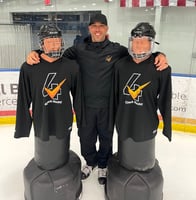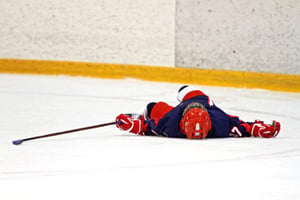Making the game SAFER, one DUMMY at a time.
Prevent Injuries and Concussions with 4Check Hockey’s Training Program
Should We Ban Checking Completely?
While the obvious thought may be, "Let’s just ban checking and contact in all of hockey," this is not a practical solution. The sport’s inherent speed and skill level, along with the varying maturity and development of players, make it nearly impossible to eliminate contact entirely. Instead, it’s essential to teach players safe and controlled techniques in a proper environment. Tools like our 4Check Hockey training dummies, along with proper coach training, provide players with the opportunity to understand their physical capabilities and learn how to safely control their bodies.
The Impact of Checking-Related Injuries in Ice Hockey
Ice hockey is a thrilling, fast-paced sport, but its physical nature can lead to a significant number of injuries, particularly from body checking. Understanding the risks and implementing safety measures is crucial for players at all levels. In this blog post, we’ll explore the impact of checking-related injuries, discuss ways to mitigate these risks, and provide insights into this growing concern.
The Risks of Body Checking
Body checking is a fundamental part of ice hockey, especially in higher levels of play. However, it comes with increased risks:
- Higher Injury Rates: Players in leagues that allow body checking face a two- to threefold increased risk of all injuries, including severe injuries and concussions.
- Common Injuries: The most frequent injuries from body checking include concussions, fractures, and injuries to the head, face, and shoulders.
Age and Skill Level Considerations
The impact of body checking varies depending on age and skill level:
- Youth Players: Younger players, particularly those aged 9–15, are especially vulnerable. Studies show that body checking accounts for a significant percentage of injuries in this age group.
- Skill Levels: Higher levels of play often see more intense physical contact, which leads to a greater incidence of injuries.
Prevention and Safety Measures
Reducing the risk of checking-related injuries involves several strategies:
- Rule Enforcement: Strict enforcement of rules and penalties for illegal checks can help reduce the risk of injuries.
- Education: Educating players on safe checking techniques and the importance of avoiding dangerous plays is crucial.
- Protective Equipment: Ensuring players wear appropriate protective gear can help mitigate the impact of collisions.
Research and Findings
Research provides valuable insights into the effects of body checking:
- Comparative Studies: Studies comparing leagues with and without body checking show a significantly higher rate of injuries in leagues that permit checking.
- Concussion Rates: Concussions are a major concern, with body checking being a leading cause. Studies indicate that concussions account for a substantial portion of all hockey injuries.
Real-Life Examples of Checking-Related Injuries
- Youth Hockey: In a study comparing youth leagues in Alberta (where checking is allowed) and Quebec (where it is not), players in Alberta had a threefold increased risk of game-related injuries, including concussions and severe injuries.
- High School Hockey: Research found that checking or being checked contributed to 41.4% of injuries among high school athletes, with the most common injuries being to the head, face, and shoulders.
- Professional Level: Even at the professional level, players are not immune. For instance, NHL player Sidney Crosby has suffered multiple concussions throughout his career, many of which were the result of body checks.
The Role of Coaches and Parents
Coaches and parents play a vital role in ensuring the safety of young players:
- Coaching Techniques: Coaches should emphasize proper checking techniques and the importance of playing within the rules. They should also foster a culture of respect and sportsmanship.
- Parental Support: Parents should be informed about the risks associated with body checking and support their children in learning safe playing techniques.
Advances in Protective Gear
Innovations in protective gear have made significant strides in reducing the impact of collisions:
- Helmet Technology: Modern helmets are designed to better absorb impacts and reduce the risk of concussions. While no helmet can completely eliminate concussions, a better understanding of concussion causes can improve player safety. 4Check Hockey's training program helps educate players on these risks.
- Padding and Guards: Advances in padding and protective guards for shoulders, elbows, and knees help minimize injuries from falls and checks.
The Future of Ice Hockey Safety
The future of ice hockey safety looks promising, with ongoing research and technological advancements:
- Rule Changes: Continued evaluation and modification of rules to enhance player safety without compromising the integrity of the game.
- Technology Integration: The use of wearable technology to monitor impacts and provide real-time data on player safety.
- Education Programs: Expanded education programs, like 4Check Hockey, for players, coaches, and parents will help promote a culture of safety and awareness.
How Our Training Dummies Help Prevent Injuries & Concussions in Ice Hockey
4Check Hockey's training dummies are a valuable tool in preventing injuries and concussions by providing a safe, controlled environment for players to practice and refine their skills. Here’s how they can help:
-
Safe Practice Environment
- Controlled Impact: Our training dummies allow players to practice body checks and other physical maneuvers without the risk of injuring a teammate. This controlled environment helps players learn proper techniques safely.
- Reduced Risk of Injury: By using dummies, players can avoid the high-impact collisions that occur during live drills, reducing the risk of concussions and other injuries.
-
Technique Improvement
- Proper Checking Techniques: Our dummies teach and reinforce proper body checking techniques. Players can practice positioning, timing, and control, which are crucial for safe and effective checking.
- Repetition and Muscle Memory: Repeated practice with 4Check dummies helps players develop muscle memory for safe checking techniques, making them more likely to use these techniques in games.
-
Simulation of Game Scenarios
- Realistic Drills: 4Check Hockey dummies can simulate various game scenarios, allowing players to practice their responses to different situations. This helps improve their decision-making and reaction times during actual games.
- Anticipation and Awareness: Practicing with our dummies helps players develop better spatial awareness and anticipation skills, reducing the likelihood of unanticipated hits, which are a leading cause of concussions.
-
Focus on Safety
- Emphasis on Safety: Using 4Check dummies in practice emphasizes the importance of safety and proper technique. Coaches can focus on teaching players how to deliver and receive checks safely, reducing the risk of injury.
- Education and Awareness: Training sessions with 4Check dummies provide an opportunity to educate players about the risks of concussions and the importance of safe play.
Real-Life Applications
- Youth Hockey Programs: Many youth hockey programs now incorporate 4Check Hockey's training dummies to teach young players the fundamentals of checking without the risk of injury to themselves or others. This helps build a strong foundation of safe playing habits from an early age.
- Professional Training: Even at the professional level, teams use training dummies to refine players' checking techniques and improve their overall safety on the ice.
Conclusion
While body checking is an integral part of ice hockey, it’s essential to recognize the associated risks and take steps to protect players. By enforcing rules, educating players, and ensuring proper equipment use, we can help reduce the incidence of checking-related injuries and make the game safer for everyone. The combined efforts of coaches, parents, and advancements in protective gear will continue to play a crucial role in enhancing player safety and preserving the excitement of the sport.
4Check Hockey's training dummies are an effective tool for preventing injuries and concussions in ice hockey. By providing a safe environment for practicing physical maneuvers, improving technique, simulating game scenarios, and emphasizing safety, they help players develop the skills and awareness needed to play the game safely. Incorporating 4Check Hockey's training dummies into practice sessions can significantly reduce the risk of injuries and make ice hockey a safer sport for everyone.




